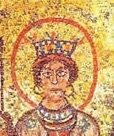n a side chapel of the Church of St. Praxedis in Rome, scarcely a ten-minute walk from the main railroad station, is a beautiful group portrait in mosaic of four women ministers. In the middle, wearing her familiar blue mantle, is the Virgin Mary. Pudentiana, on Mary's left, is of course related to the Roman Pudens, sometimes thought to be the same Pudens named by St Paul in 2 Timothy 4:21.

It is commonly accepted that a woman named Pudens owned the properties where the Church of St Pudentiana, and farther on, the Church of St Praxedis, now stand, and that these family lands later became church property as the era of house churches passed into the era of church buildings. Excavations under the church of St Pudentiana have shown that a public bath was constructed adjoining the families’ dwelling. In this way, numbers of people could enter and pass into the house church without arousing suspicion that a gathering of Christians was taking place. The baths, probably closed at night, could also be used for baptisms, which were by immersion and required a pool.
St Praxedis, shown in the mosaic wearing a jeweled crown, is on Mary's right. She has a Greek name rather than a feminine version of Pudens, so she was probably a slave rather than a biological descendant. Many Romans bought Greek slaves to teach their children to speak Greek. A girl slave would teach a daughter.
Some churches display a row of portraits of their pastors over the years, and this mosaic is similar in intention. Theodora, about 820 A.D. and Praxedis, about seven hundred years earlier, stand shoulder to shoulder, the living and the departed, both wear their Episcopal crosses, indicating their status as bishops. They attest to a conscious succession in church office from Mary, through Praxedis and Pudentiana, to Theodora, who, at the time of her portrait, was bishop of the titular church of St. Praxedis. Rome has traditionally not one but many bishops, stemming from its numerous early house churches. This tradition is continued by the cardinals, who are bishops; each of them is named to one of these churches. The church of St. Praxedis still has a cardinal/bishop.
Dr. Dorothy Irvin, "The Archaeology of Women's Traditional Ministries in the Church"
and http://video.google.com/videoplay?docid=-2648827455394718550



















